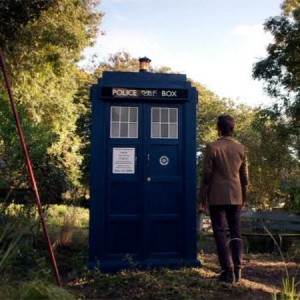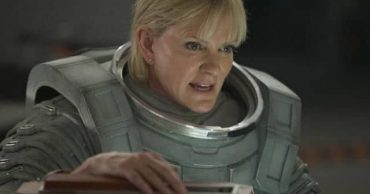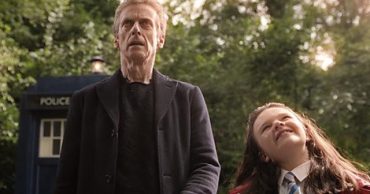 For the second week in a row, I found myself gleefully entertained by an episode of Doctor Who. “The Crimson Horror” was a Grand Guignol of a good time, delighting in its bleak settings, unrestrained performances and a marvelous mix of horror and comedy.
For the second week in a row, I found myself gleefully entertained by an episode of Doctor Who. “The Crimson Horror” was a Grand Guignol of a good time, delighting in its bleak settings, unrestrained performances and a marvelous mix of horror and comedy.
Quick recap: For the first fifteen minutes of “The Crimson Horror,” we barely see The Doctor and Clara. The first quarter of the episode follows the fan-favorite Victorian team of Jenny, Madame Vastra, and Strax, who are investigating a mysterious rash of missing people, some of whom turn up in the local canal, their skin a nuclear shade of red.
Their services are retained by the brother of one of the deceased; a reporter who was investigating the secrets of Sweetville, a sinisterly planned community. He photographs his brothers eyes under the belief that a dead person’s eyes retain an image of the last thing it saw.
Jenny develops the film and – wouldn’t you know it? – captured in the corpse’s corneas is a desperate-looking Doctor.
Meanwhile, we learn more about Sweetville. It is run by the sinister revivalist Mrs. Gillyflower. She rules both the townspeople and her blind daughter, Ada, with the compassion of a cobra.
In an example of some of the lovely dialogue and character beats writer Mark Gatiss gives us us, Madame Vastra explains Sweetville admits only the most perfect and beautiful applicants. “You may rely on me,” potato-headed Strax boasts. After a perfectly timed double take, Madame Vastra explains “I was thinking of…Jenny.” Strax is stricken, but recovers with “Jenny? If this weak and fleshly looking boy is to represent us…” and then lists an armory’s worth of weapons they should bring. Priceless.
Jenny dutifully infiltrates Sweetville and finds The Doctor. He’s been infected with The Crimson Horror. Turns out the toxin either kills or puts you in a kind of paralysis. Thanks to The Doctor’s alien physiology, he suffers neither fate, but becomes a Frankenstein-like zombie, whom Ada has been keeping locked up as her “monster.”
In another of the episodes many highlights, Jenny kicks off her petticoats to reveal a Matrix-like black leather fighting unitard before bringing some Kung-Fu to Sweetville’s enforcers. If the sudden erectness of his sonic screwdriver is any indication, even The Doctor isn’t immune to her charms.
Later in the episode, we’re treated to the most efficient-ever exposition, as The Doctor explains to Madame Vastra and company how he came to Sweetville. Told in an series of sepia-toned, scratchy film clips, the old-timey flip-book styled summary tells us everything we need to know in four minutes. It couldn’t be more engaging, clever, or perfect for the show. It’s the kind of playful kookiness that mades “Doctor Who” so endearing.
Clara, as can be expected, didn’t die upon exposure to the toxin. She’s preserved in a giant bell-jar until rescued by The Doctor rest of the Scoobies. The last time the Vastra Detective Team saw Clara was in the “The Snowmen,” where she died. “How is she alive again?” they ask. “I don’t know,” The Doctor replies smiling, for the first time more seeming happier with her company than distracted by her mystery.
Turns out Mrs. Gillyflower has been working with an alien parasite she calls Mr. Sweet. In return for feating off her blood, he gives her his toxin – the red death, “The Crimson Horror.” It’s not really clear how the he produces so much of the stuff- we see huge containers and vials, nor what exactly it does, but whatever. Somehow, in Victorian England, Mrs. Gillyflower has built an immense steampunk rocket-ship, which will explode in the outer atmosphere and rain ruby death on everyone.
Naturally, The Doctor and team thwart her plans. The plot mechanics aren’t nearly as interesting as the performances, which stood among the series’ best. Dame Diana Rigg gives a master class in play-it-to -the-rafters villainy. Her real life daughter Rachel Stirling journeys from helpless victim to vengeful hellion. “You perfidious hag,” she calls her mother at the show’s finale, “you virago! You harpy!” In lesser hands, these lines would be irretrievably over-the-top; these actresses sell them perfectly.
The sense of scene throughout this episode was exemplary. Writer Gatiss and director Saul Melzein work together seamlessly. Doctor Who always does the Victorian era well; this week they outdid themselves. Was I the only viewer reminded of Sweeny Todd?
Thoughts and theories:
- Not many this week. This was a perfect one-and-done…until the end.
- Clipped onto the show’s last minutes, Clara returns home to find photographs of herself on a laptop computer. Unfortunately, the photos are from her previous encounters with The Doctor. They’ve been collected by the two children she’s been “nannying” in the present day. Observing the photos’s likenesses to Clara, not to mention her “boyfriend” (The Doctor) they conclude she must be time traveling with her alien beau.
- Nothing here worked. The idea that the children stumbled across these photos (not to mention that they were taken at all and found their way onto the internet) and assumed they were proof of time travel as opposed to, say, Photoshop, was absurd. If the show needed a justification for their knowing her secret, it would have been a lot easier – and more sensible – had they just watched her emerging from a suddenly-appearing TARDIS. Tacked on at the end, this hard-to-swallow, clumsily scripted scene was like finding a dead roach at the bottom a delicious bowl of soup. It was clearly a set-up for next week, when the kids blackmail Clara into taking them along; too bad it sullied an otherwise almost-pefect episode.
 Follow Us
Follow Us






